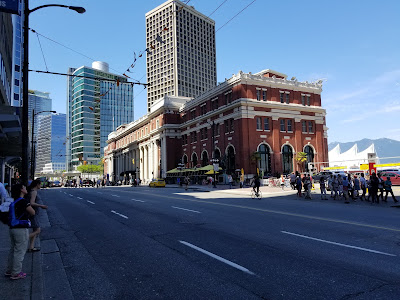Waterfront
is a major intermodal public transportation facility and the main
transit terminus in Vancouver, British Columbia, Canada. It is located
on West Cordova Street in Downtown Vancouver, between Granville and
Seymour Street. The station is also accessible via two other
street-level entrances, one on Howe Street to the west for direct access
to the Expo Line and another on Granville Street to the south for
direct access to the Canada Line.
The
station is within walking distance of Vancouver's historical Gastown
district, Canada Place, Convention & Exhibition Centre, Harbour
Centre, Sinclair Centre, and the Vancouver Harbour Flight Centre float
plane terminal. A heliport operated by Helijet, along with the downtown
campuses for Simon Fraser University and the British Columbia Institute
of Technology, are also located within the vicinity of the station.
Waterfront
station was built by the Canadian Pacific Railway (CPR) and opened on
August 1, 1914. It was the Pacific terminus for the CPR's
transcontinental passenger trains to Montreal, Quebec and Toronto,
Ontario. The current station is the third CPR station. The previous CPR
station was located one block west, at the foot of Granville, and unlike
the current classical-styled Waterfront station was built in "railway
gothic" like the CPR's many railway hotels.
In
1978, when Via Rail took over the passenger operations of the CPR and
the Canadian National Railway, it continued using both railways'
stations in Vancouver, but a year later, Via consolidated its Vancouver
operations at Pacific Central Station, the CN station near False Creek,
and ceased using the CPR station. The last scheduled Via passenger train
to use Waterfront station departed on October 27, 1979.
Waterfront
station's transformation into a public intermodal transit facility
began in 1977. That year, the SeaBus began operating out of a
purpose-built floating pier that was connected to the main terminal
building via an overhead walkway above the CPR tracks. The CPR's
passenger platform and some of its tracks were torn up in the early
1980s to make way for the guideway of the original SkyTrain line (Expo
Line), which opened on December 11, 1985. During Expo 86, SkyTrain
operated special shuttle trains between Waterfront station and
Stadium–Chinatown station (then named Stadium station), connecting the
Canadian Pavilion at Canada Place to the main Expo site along False
Creek.
A
private ferry company, Royal SeaLink Express, ran passenger ferries
from a new dock on the west side of the SeaBus terminal to Victoria and
Nanaimo in the early 1990s, but ultimately folded. In 2003, HarbourLynx
began operating out of Royal Sealink's old facility at the SeaBus
terminal. In 2006, following major engine problems with their only
vessel, they folded as well.
In
1995, platforms were built adjacent to the SkyTrain station for the
West Coast Express, which uses the existing CPR tracks. The platforms
for the West Coast Express were built in the same location as the old
CPR platforms.
In
2002, Millennium Line trains began to share tracks with the Expo Line
at Waterfront station. The lines continued to share tracks until late
2016, when an Expo Line branch to Production Way–University station was
created in replacement of the Millennium Line service between VCC–Clark
and Waterfront stations.
In
2009, the Canada Line opened with separate platforms which are
accessible via the main station building, but require leaving the fare
paid zone when transferring between other modes. Waterfront station
serves as a common terminus point for both the Expo Line and the Canada
Line.
Waterfront
station was one of the first stations to receive TransLink's "T"
signage, denoting a transit station. This signage was originally
installed in the downtown core of Vancouver to help visitors during the
2010 Olympics, as it made transit hubs easier to identify.
In
2018, TransLink announced that Waterfront's Canada Line platforms, as
well as two other stations on the line located within downtown
Vancouver, would receive an accessibility upgrade which includes
additional escalators, as most Canada Line stations were built with only
up escalators initially. Construction is expected to begin in early
2019.
Waterfront's
main station building was designed in a neoclassical style, with a
symmetrical red-brick facade dominated by a row of smooth, white Ionic
order columns. The Ionic columns are repeated in the grand interior
hall, flanking the perimeter of the space. The main hall features two
large clocks facing each other high on the east and west walls.
Paintings depicting various scenic Canadian landscapes, completed in
1916 by Adelaide Langford, line the walls above the columns. The
Montreal architecture firm Barott, Blackader and Webster was responsible
for designing the main station building.










No comments:
Post a Comment